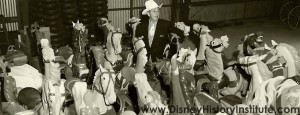 |
| Walt and Carousel Horses Purchased for Disneyland – 1955 |
Walt’s First Park
Part 6 – Conclusions
by Todd James Pierce & Paul F. Anderson
The biography of Walt Disney is often divided in half: his early years, up until about 1950, when animation was the focus of his artistic pursuits, and his later years, when he gave himself over to real estate projects such as Disneyland, Disney World, EPCOT, and Mineral King. With the story of Hollywood Sports Garden, however, it seems that Walt actively pursued both real estate developments and feature films fairly early in his life. By the end of the 1930s Walt had tackled both his first animated feature (Snow White) and attempted to build his first massive amusement center. For the rest of his life, he developed and revised both of these concepts with more successful and sophisticated projects.
Over the phone, as Paul Anderson and I talked about Hollywood Sports Garden, we imagined how Walt’s life might have been altered if the Garden had been successful. Paul believed that success with the Garden might’ve brought Walt more quickly to Disneyland. I, on the other hand, thought success with the Garden might’ve fulfilled Walt’s need to develop a large amusement complex and made him less likely to pursue Disneyland in the 1950s. Regardless, the experience with the Garden undoubtedly prepared Walt to pursue a large amusement project fifteen years later.
Through the Garden, Walt explored ways to raise funds; he also managed a second business in addition to the studio. Both of these skills would be essential to his later work on Disneyland. The most important lesson, however, was initially lost on him. Hollywood Sports Garden failed primarily because the planning team didn’t persuade local residents, early on, that the arena would improve their community and be a boon to their way of life. In 1953, Walt lost his original site for Disneyland—then called Mickey Mouse Park—because he had failed to convince the good people of Burbank that an amusement park next to his studio would improve their city. Later that same year, when Walt finally settled on Anaheim as the next city in which he would attempt to build his amusement park, he sent his men in early to persuade city officials and the Chamber of Commerce that his project would improve Anaheim. With these two failures behind him, Walt now understood that it was essential to manage public opinion and to work as a good neighbor. He promised the citizens of Anaheim that his studio would participate in local festivities, such as the Halloween Festival. He also guaranteed the city of Anaheim that he would primarily hire local men and women to work at his park, thereby ensuring that profit from Disneyland would, in part, go home with local workers.
The design concepts of Hollywood Sports Garden are also reflected in later projects that interested Walt. In 1938 and 1939, reporters commented that Walt was absorbed with the technology of the sports arena, particularly the moveable “elastic walls” that could section off the open floor into a series of smaller rooms or intimate theaters. This same interest in architecture and technology would form one of his underlying attachments to EPCOT, that experimental city he once wanted to build in Florida. The ability to use the arena for trade shows and cultural events is almost identical to his much-later plans to build a convention center next to Disneyland—a plan that, like the Garden, was never realized. Lastly, Walt’s interest in sports as a type of entertainment venture resonates loudly with some of his final projects—particularly the Mineral King ski resort and, of course, Celebrity Sports Center.
Celebrity Sports Center—with its pool, its restaurant, its 80 lanes of bowling—was a sports-entertainment complex that, in 1960, Walt Disney opened in Denver. Coincidentally Walt’s longtime friends, Bing Crosby and Jack Benny invested in this project as well.
The idea of genius presently has two popular modes of presentation: there are those prodigies who, like Picasso, understand and expressed their genius at an early age, and there are other masters who, like Cezanne, expressed their genius through great works late in life. Walt appears to hover between these two models. Though he was clearly not a child prodigy, he was drawn relatively early to the two fields that he would master and transform—animation and environmental space. Both ideas appear to be with him at a fairly young age, though it would take years—working mostly on the first and then on the second—for these ideas to find ideal forms. It would be genius through revision—or as Walt might have termed it, through the hard and often frustrating work of imagination.
==============================================================
With this, we conclude the story of Walt’s First Park. See you all in a few weeks. Post up your comments below. –TJP
PS We are running this series simultaneously on our podcast–click here to subscribe.

Really interesting and well-written story. How did the rest of the studio feel about Walt switching from Snow White to an entertainment center so quickly? Could it have had some impact on production of Pinocchio.
Hi TM,
Thanks for the note. You have an interesting question. In terms of time allocation, I’d say that much of the time that Walt devoted to polo (and probably then some) was shifted over to HSG. But, for me, the more interesting concern is implied in the second half of your question: because early biographies (particularly the one by Bob Thomas) were so focused on Walt’s work in animation, do we really have a full (or maybe fully accurate) picture of Walt’s ambitions at the end of the 1930s? I’m not sure I have an answer for that. But I think Walt’s involvement in HSG–particularly as President–certainly opens up this topic for discussion and exploration.
-TJP